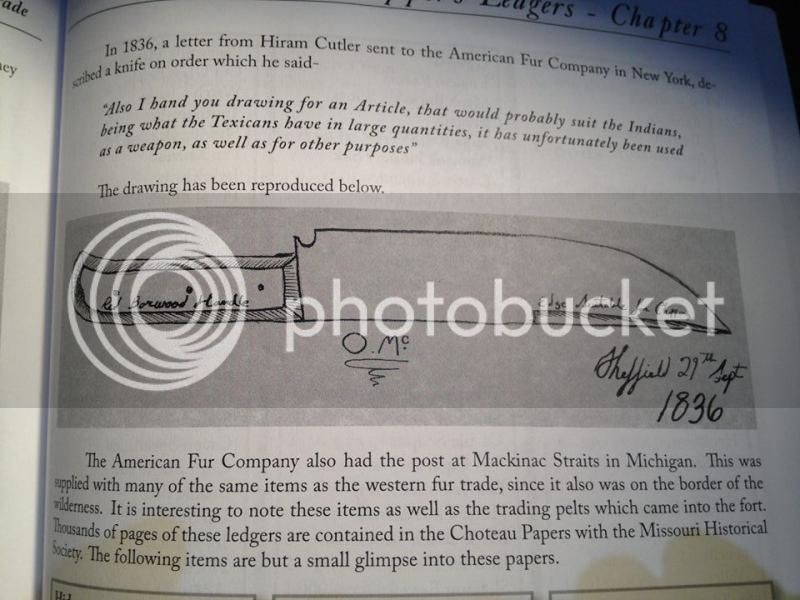Wes/Tex said:
Luke MacGillie said:
This image is Oliver McCloskey's copy of a sketch sent east in 36 The question of course is how many "Texicans" were up there in the mountains at the time?
True. From what I've found through the years, most anyone from Texas or the Mexican Coahuila y Tejas states probably was involved int eh Santa Fe trade in the most southern mountain area...and probably too busy being chased all over God's green earth by the pesky Comanches! :wink:
And not just in the "legal" trade - an encounter by the US Miltary with Texican freebooters in 1843. No Knives
In 1843 Captain Philip St. George Cooke, in command of a dragoon detachment patrolling an area along the north bank of the
Arkansas River, encountered a band of Texas "irregulars/freeboters" who were threatening a Santa Fe caravan. Anticipating trouble
from the captain and his frontier-toughened troops, the Texans hastily concealed a number of their best weapons (including some
Colt repeating rifles), but Cooke nevertheless relieved them of various other guns, including muskets, shotguns, pistols, and rifles.
Among the rifles Cooke confiscated and later turned in at Fort Leavenworth were:
30 flint lock rifles, valued at eighteen dollars each, including the barrel of one which has no stock, which appears to have been lost in
transportation.
12 percussion rifles, valued at twenty two dollars and fifty cents, including the barrel of one which has no stock. . . .
3 half stock Middletown rifles, percussion lock, valued at eighteen dollars each.
1 full stock percussion lock [Middletown rifle], valued at eighteen dollars.
1 halfstock flint lock Middletown rifle, valued at eighteen dollars.
NOTE: The "Middletown rifles" were probably altered U.S. Model 1817 contract arms made by Simeon North
Totals: 31 flinters and 16 percussion
Besides the forty-seven rifles and two "American dragoon carbines" (Hall's maybe - could be either flint or caplock) the Texans were carrying twenty-eight smoothbores of various types:
15 English flint lock shot guns.
3 Tower pieces (most likely India pattern Brown Bess flinters)
1 Large American flint lock shot gun.
2 Double barrelled flint lock, stub and twist, shot guns.
4 Percussion lock, double barreled, stub and twist, shot guns.
1 American musket.
2 Texas muskets (most likely the flintlock M1822 type muskets supplied to Texas by Tryon of Philadelphia in 1840 and marked Texas with a star on the lockplates) - a total of 860 were purchased out of the 1,500 ordered.
Totals: 23 flinters and 4 caplock - the American musket could be of either ignition so was not included in the totals.
The Texas "freebooters" were also rather well equipped with pistols - Cooke confiscated:
4 pairs of flint lock holster pistols, valued at twenty dollars a pair.
2 pairs percussion lock pistols, valued at forty dollars a pair.
8 flint lock holster pistols, odd, valued at ten dollars apiece.
7 percussion lock belt pistols, valued at fifteen dollars apiece.
1 percussion lock duelling pistol, valued at forty dollars.
Totals: 16 flinters and 13 caplock - just about half and half
Another mention of Texans with Bowie Knives
After arriving in Texas in the early 1840s, Nelson Lee joined the Rangers, describing their "uniform" and equipment as "buckskin moccasins and overhauls, a roundabout and red shirt, a cap manufactured by his own hands from the skin of a coon or wildcat, two or three revolvers (Colt's or pepperboxes?) and a bowie knife in his belt, and a short rifle on his arm."
 About the time I moved here and the hippies weren't profiled on hwy 23 south by the local sheriffs department during music festivals. :shake: Tree.
About the time I moved here and the hippies weren't profiled on hwy 23 south by the local sheriffs department during music festivals. :shake: Tree. About the time I moved here and the hippies weren't profiled on hwy 23 south by the local sheriffs department during music festivals. :shake: Tree.
About the time I moved here and the hippies weren't profiled on hwy 23 south by the local sheriffs department during music festivals. :shake: Tree.









